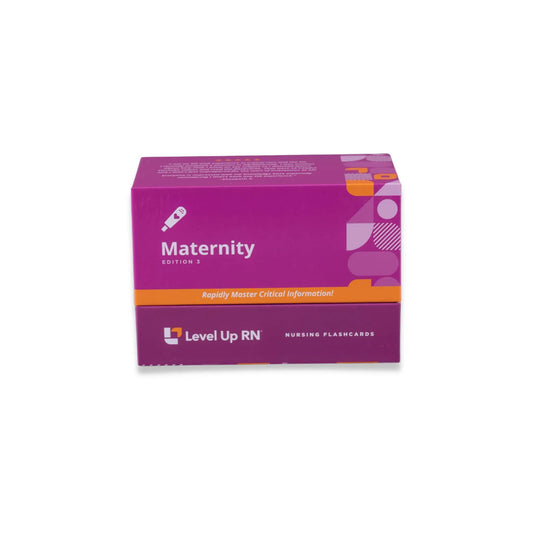When you see this Cool Chicken, that indicates one of Cathy's silly mnemonics to help you remember. The Cool Chicken hints in these articles are just a taste of what's available across our Level Up RN Flashcards for nursing students!
Maternity Nursing - Flashcards
This article focuses on factors affecting labor, especially fetal position and fetal station. The Maternity Nursing series follows along with our Maternity Nursing Flashcards, which are intended to help RN and PN nursing students study for nursing school exams, including the ATI, HESI, and NCLEX.
Factors affecting labor
When considering the factors affecting labor, we use a shorthand: the 3Ps: the passageway, the powers, and the passenger.
Passageway
The passageway is another name for the birth canal (comprising the cervix, vagina, and pelvis), and concerns the patient’s anatomy. Is their pelvis tilted? How is their cervix? These anatomical considerations may affect a patient’s ability to birth a baby vaginally or alter the labor in some other way.
Powers
Powers refers to contractions. How strong are the contractions, and how are they affecting the cervix? If contractions are ineffective — if they don’t change the cervix in preparation for labor — it’s possible that the passageway is inadequate, and this will affect the patient's ability to give birth.
Passenger
The passenger is the fetus (and the placenta). The following factors will affect labor: fetal head, fetal lie, fetal presentation, and fetal attitude. Two other key elements of labor include fetal position and fetal station, which are discussed in more detail below.
Fetal head
Fetal head describes both the size and molding, or shape, of the fetus’s head.
Head molding refers to changes in shape of the fetus’s head as it experiences pressure during the journey through the birth canal. A tight birth canal may result in squeezing the fetus’s head into a slightly oblong shape, a common occurrence that usually disappears in the days after birth.
Fetal lie
Fetal lie describes how the fetus is positioned in the womb. It may be longitudinal, transverse, or oblique.
- Longitudinal: in a longitudinal lie, the fetus’s spine runs in the same direction (parallel) as the mother’s spine.
- Transverse: in a transverse lie, the fetus is positioned horizontally across the uterus, rather than vertically.
- Oblique: in an oblique lie, the fetus’s head is against the mother’s hip, high above the birth canal, with no part of the fetus’s body pressing against the cervix.
Fetal presentation
Fetal presentation is the first part of the fetus to enter the pelvic inlet. It may be the head, the chin, a shoulder, or the fetus may be presenting as breech (emerging feet-first).
Fetal attitude
Fetal attitude describes the relationship of fetus’s body parts to one another, described as either flexed or extended:
- Fetal flexion is when the fetus’s chin is tucked close to its chest, and the other limbs are similarly tucked, which makes it easier for the fetus to pass through the pelvis.
- Fetal extension is the position of the fetus during labor and delivery, where the head is extended back.
Fetal position
Fetal position, as the name suggests, describes how the fetus is positioned in the womb and how it will present (which part of the baby emerges first).
The fetus may be positioned in any number of ways, so a three-letter label is assigned to clarify the position. Note that the direction of the fetus’s back determines its relative position.
The first letter is either "L" or "R," that is, "left" or "right." Is the fetus oriented toward the left or right?
The second letter describes which part of the baby is about to present in the pelvis: "O" (occiput or head-first), "S" (sacrum or butt-first), "M" (mentum or chin-first), or "Sc" (scapula or arm- or shoulder-first).
The third letter describes the direction the fetus is facing, relative to the mother: "A" (anterior, facing forward), "P" (posterior, facing backward), or "T" (transverse, lying on its side — horizontally across the uterus).
The optimal fetal position is LOA: left, occiput, anterior. In this situation, the fetus is positioned so that the occiput (head) will emerge first; the fetus is angled toward the left side of the mother’s pelvis and is facing the mother’s front (anterior). This position is usually preferred for a well-facilitated birth.
Different positions will result in different birth experiences for mother and baby.
Fetal station
Fetal station refers to how far has the head or presenting part descended into the pelvis.
Station zero means at the level of the ischial spines, the narrowest part of the mother’s pelvis. At station zero, the fetus is said to be "engaged."
If the fetus is stationed higher up, that is designated a negative number. If stationed lower (closer to the vaginal opening), that is designated a positive number.
A negative-3, for example, indicates the baby is not at an optimal station for delivery. At plus-3, the baby is on its way!



1 comment
Excellent explanation thank you